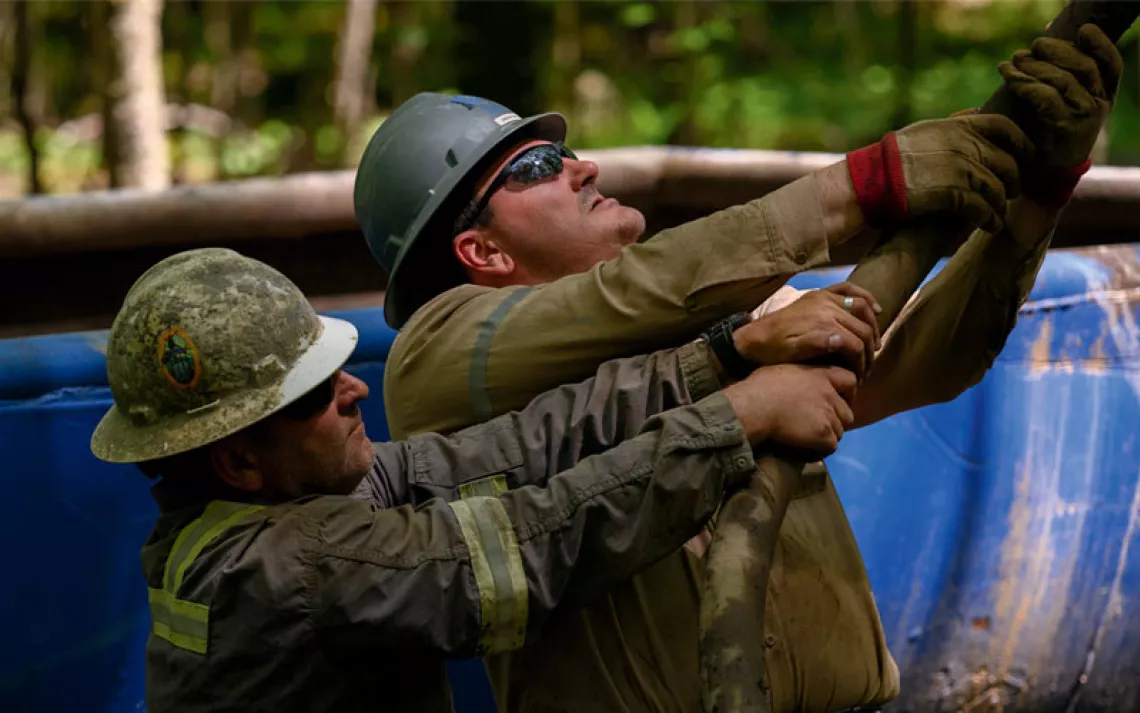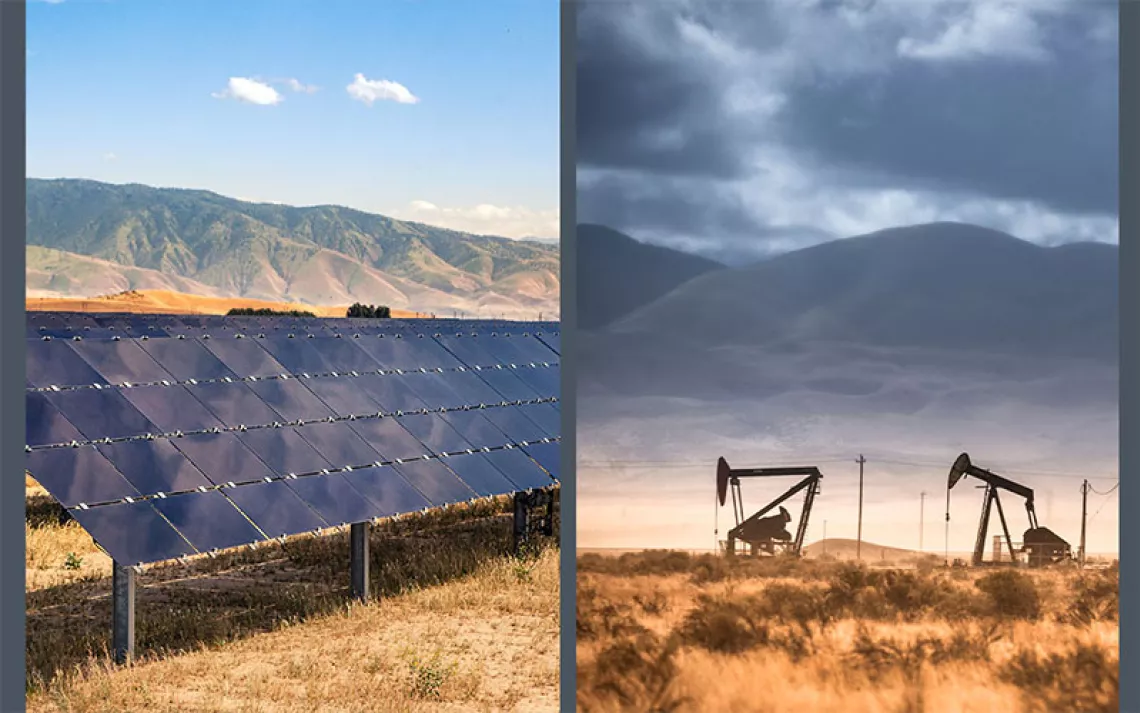Public Lands for Whom?
Zinke scapegoats fourth graders, grandmas; delivers giveaways to oil companies

Ryan Zinke testifies before the Senate Committee on Energy and Natural Resources on March 13, 2018. | Photo by AP Photo/Jacquelyn Martin
Mining corporations foreign and domestic can dig for gold, silver, copper, and other precious metals on public lands without paying royalties to the U.S. government and acquire mining rights for as little as $5 per acre. For fossil fuel companies, the Interior Department is moving to slash the royalties they pay for offshore oil and gas—from a current rate of 18.75 percent down to 12.5 percent. At the same time, the Bureau of Land Management has proposed reducing by 25 percent the grazing fees that ranchers pay to run livestock on public lands, and that comes on top of an 11 percent reduction that was put in place last year. Under the Trump administration, it’s now easier than ever for private interests to profit off the lands that are held by all Americans.
For Interior Secretary Ryan Zinke, there’s nothing wrong with such giveaways to vested interests. But there’s another group of public-lands free riders that we need to worry about, according to the secretary: schoolkids, veterans, people in wheelchairs, and senior citizens who visit our national parks.
Last week Zinke appeared before the House and Senate natural resources committees to explain the proposed 2018–19 budget for his department. His testimony included lots of fireworks, including a heated exchange with Senator Maria Cantwell, a Democrat from Washington, over the secretary’s expensive travel habits, and an admission from Senator Ron Wyden, an Oregon Democrat, that his support of Zinke’s nomination was “one of the biggest regrets of my time in public service.”
Then, during questions about the secretary’s proposal to dramatically increase entrance fees at 17 national parks, Zinke complained that people entering a national park are charged per vehicle, and some people get discounted entry. Meaning that, in Zinke’s view, the other passengers are getting a free pass.
“Basically, one person, with a pass, everyone in that car comes in free,” Zinke told senators, and then went on to question the wisdom of offering discounts to kids and senior citizens. “When you give discounted or free passes to elderly, fourth graders, veterans, disabled, and you do it by the carload, there’s not a lot of people who actually pay at our front door.”
Never mind that some of this is plain wrong—veterans, in fact, don’t get free entrance to national parks (though active duty service members and their dependents do). It’s worth taking Zinke’s statements seriously, because they help illuminate the thinking behind the secretary’s policies: Oil and gas companies deserve discounts while kids and senior citizens should have their discounts taken away.
Nearly a year ago, in one of his first press conferences as interior secretary, Zinke declared, “No one loves our public lands more than I. You can love them as much—but you can’t love them more than I do.” Let’s take Zinke at his word and trust that he does, in fact, hold a deep affection for our public lands. But public lands for whom? Not kids and their grandparents, that is clear. Zinke evidently believes that our federal lands’ highest use is to be an ATM for mining companies, oil and gas corporations, and ranchers.
A close look at Zinke’s first year in his post and his proposed budget proves the point.
Let’s start with the budget. Zinke and his boss, President Donald Trump, propose to cut the Interior Department’s budget by 16 percent. That would include a 7 percent reduction in the National Park Service budget, which would require cutting as many as 1,835 park ranger positions. The U.S. Fish and Wildlife Service would experience a similar reduction in spending, even though agency employees complain that they are barely keeping some wildlife refuges operating with “duct tape and bailing wire.” Zinke would nearly zero-out the Land and Water Conservation Fund, a long-standing program that has been successful at acquiring new public lands and which enjoys bipartisan support. (Last week, 28 House Republicans sent a letter to Speaker Paul Ryan calling for the fund to be reauthorized.)
Budgets are, famously, statements of principles and values. Administrations fund those things that they believe are important. Zinke’s proposed budget makes his priorities plain: Sustaining our national parks and wildlife refuges is not of great importance.
The national parks are suffering from a nearly $11 billion deferred maintenance backlog, which even Zinke realizes is untenable. So he’s proposing to create an $18 billion fund for park projects that would be paid for by receipts from energy produced on federal lands and waters. Zinke boasted that this will be “the largest investment in our public lands’ infrastructure nation’s history.” (Actually, the biggest investment in our public lands came during the Depression-era Civilian Conservation Corps, which ran from 1933 to 1942 and cost about $58 billion in today’s dollars.)
But Zinke’s proposal relies on creative accounting that simply doesn’t add up. Witness the Interior Department’s reduction of royalty rates on offshore oil and gas extraction. As Politico has reported, last year career staff at the Interior Department’s Bureau of Ocean Energy Management recommended an 18.75 percent royalty rate for an August 2017 auction of offshore leases in the Gulf of Mexico, and predicted the auction would generate $202 million. But then the agency lowered the royalty rate to 12.5 percent, the legal minimum, and the auction raised only $121 million, 40 percent below the initial estimate. And these royalty reductions come at a time of low oil prices. In 2008, the federal government actually did earn $18 billion from energy receipts, but at the time oil was trading for as much as $140 a barrel; last week the price was $61.
Zinke’s plan for earning billions of dollars from energy receipts even as his department slashes royalty rates is just supply side economics poorly tailored for our public lands. And it raises questions about the sincerity of his pledge to raise new monies for the Park Service. After all, it’s hard to raise money when you’re slashing revenue. Unless, that is, you’re more interested in giving the oil industry a break than you are in addressing the national parks’ maintenance backlog.
Meanwhile Zinke's agency is doing its best to shield its operations from public view. An internal BLM memo obtained by the Washington Post reveals that some agency staffers have recommended limiting the number of Freedom of Information Act requests that any one group or individual can file, while also increasing fees for FOIA requests—a clear attack on the public’s right to know what interior officials are doing. Also, according to congressional Democrats, an Interior Department policy committee has recommended limiting how the public provides input into proposed development projects under the National Environmental Protection Act. And, Politico reports, Secretary Zinke has sometimes used a private email account to conduct official business, raising further questions about the secretary’s commitment to transparency.
Sweetheart deals for oil companies. Scrooge-like treatment for kids and seniors. And all of it done under as much cover as possible. This isn’t the behavior of a conscientious public servant. Zinke likes to fancy himself as the second coming of Theodore Roosevelt, but given his actions during his first year in his post, he's more like the reincarnation of James Watt, the Reagan-era interior secretary who is often regarded as the worst steward of public lands ever. Zinke seems well on his way to taking that title for himself.
 The Magazine of The Sierra Club
The Magazine of The Sierra Club



